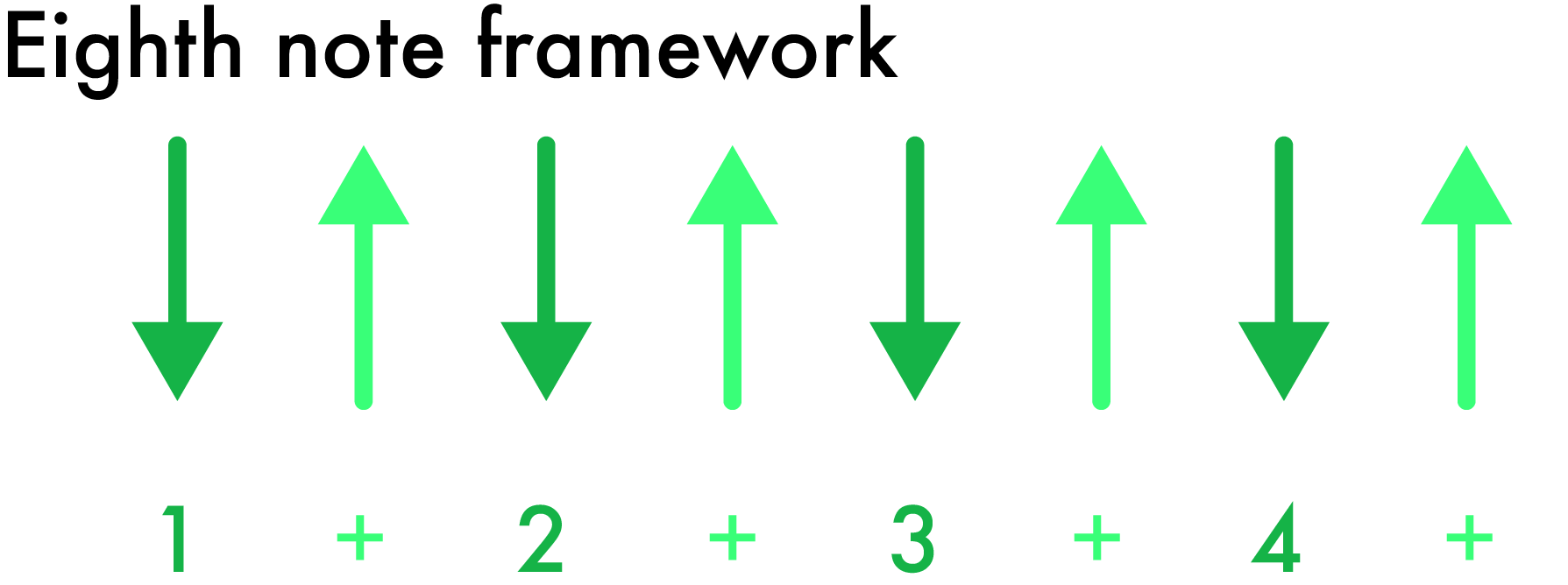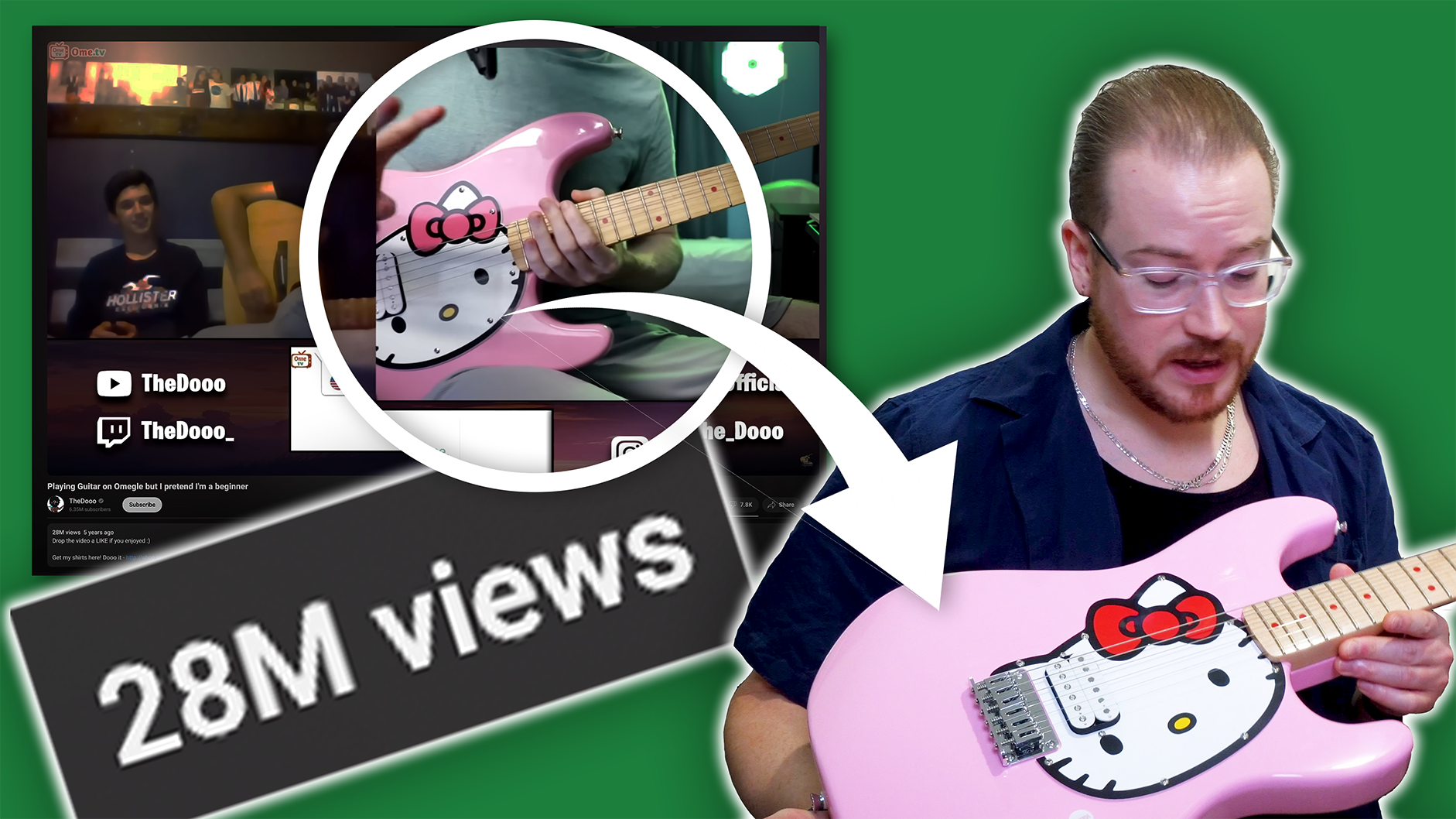How to master strumming as a beginner guitarist
The four strumming frameworks
Every strumming pattern you will ever play is going to fit inside one of four frameworks.
The four strumming frameworks are:
The eighth note framework
The sixteenth note framework
The primary six-eight framework
The secondary six-eight framework
This means that if we know what it feels like to play each individual slice of these frameworks, then we inherently have the muscle memory to play every strumming pattern we will ever want to play. This is due to the fact that strumming patterns are consistent in regard to their movement. A down-strum will always occur on the beat and an up-strum will always occur on the off-beat. Our arm is always moving due to the principle of constant motion. Different strumming patterns are simply a result of us deciding whether or not we want to hit the strings on the way past.
Fig. 1: Eighth note framework
Of course, there are always going to be a few exceptions. But when we understand why there are exceptions (as in there might be a specific reason to break the rules in a certain situation) everything makes sense.
This consistency of these frameworks means that the movements we use to play any particular strumming pattern will be predictable. This means that, as we focus on integrating our three types of understanding (intellectual, physical, and aural), we’ll get to the point where us hearing a rhythm also means we know what it feels like to play. And, because we know what it feels like, we’ll also intuitively know which beat the notes are occurring on. Integrating our three types of understanding means we never have to stop and figure out a strumming pattern. We’re able to hear a rhythm and intuitively know how to play it.
Fig. 2: Sixteenth note framework
Fig. 3: The primary and secondary six-eight frameworks
What is intentional strumming?
Intentional strumming is the ability to play whatever we want in the moment. It’s not random, but it’s not premeditated. The most effective way to learn how to strum is to treat each beat as its own individual unit. We might have a basic strumming pattern that we use as a starting point, but from that starting point, we are able to alter the individual beats however we like. This allows us to do things like mimic the rhythm of the vocal melody (which is a great way to make the guitar part feel like it is locked in with the vocal), emphasize certain beats, or build and release tension to make a song feel more dynamic.
Here's a good analogy that helps us understand the level we want to get to with our strumming:
How much time do you spend thinking about the act of walking while you’re walking?
Probably none. It's not something you do.
You just think to yourself, I want to go over there.
Your default way of getting there is probably to walk over normally (the strumming pattern you might use as a starting point), but if you felt like it you could jump up onto the curb and balance along that.
You could start skipping.
You could run.
These all represent ways we could alter our default way of getting somewhere in order to make the journey more interesting. Moving from point A to point B is the objective, but how you get there is up to you.
Regardless of how creative you get, you don’t ever think, Okay, now I’m going to move my legs to jump up onto this ledge now put one foot in front of the other.
Rather, you simply think, Oh, I want to go over there. And then you just do it.
You don’t spend any time thinking about what you are doing from a physical or a technical point of view. The physical act of walking (or however you choose to get from point A to point B) just becomes an extension of your intellectual intention to move from one place to the other. This is exactly what it’s like with strumming. This is why we're taking the trouble to integrate our three types of understanding. Once our understandings are integrated, we don't have to think about what we're doing because we hear what we want to happen in our head and are able to just do it.
How to practice strumming patterns
The problem with learning random strumming patterns is you don’t necessarily cover all the rhythmic permutations for which we want to develop muscle memory. If we practice individual strumming patterns, we are also not likely to integrate our intellectual understanding by identifying what’s happening with each individual beat as we play. A student who just learns strumming patterns will probably end up going through enough permutations to eventually be able to vary their strumming patterns however they want, but this approach is not very effective.
It’s far more effective to identify the variations you can play and follow a practice schedule that takes you through all of those. Then you’ll be able to play all of them. But, more importantly, you’ll also understand them on a beat-by-beat level rather than thinking of the strumming pattern as a unique sequence of movement that you learned one time.
In this approach to practice, we identify the objective (intentional strumming), and then focus on developing the specific things we need in order to hit that objective. Often this results in us needing to go through a series of exercises that aren’t very exciting, so this is where balance comes in. A good practice routine will take us through the things we need to do in order to progress as effectively as possible while also making sure that we are applying and understanding what we are doing throughout the process.
An example of this might look like learning songs alongside our technical practice in order to observe what we’re doing in action. The more time we spend learning songs the longer it will take us to master the concept, but it will make the process more fun. Every student’s needs are different and there is no ‘correct’ amount of time you should spend on one aspect verses the other.
Learning as a kid vs. learning as an adult
Unfortunately, only playing songs and simply hoping we end up with the skills we want to develop is not an effective approach to practice. Can it be done? Yes. But this approach is better utilised with young kids.
When you start out as a kid, you don’t think, Oh, I want to get good.
You’re just thinking, Oh, this is fun! And then you start learning songs and your skills develop as a result of your natural fascination with the guitar.
As a kid, the priority is not to do things as fast and effectively as possible. You learn through play. But as an adult with a busy life, that kind of approach is usually not very helpful.
However, just doing the boring stuff is also not necessarily fun. So it becomes a balancing act to structure things and apply them in the most effective way possible.






